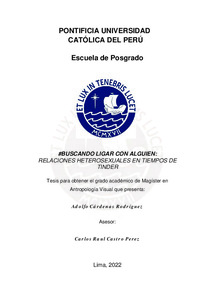| dc.contributor.advisor | Castro Perez, Carlos Raul | |
| dc.contributor.author | Cardenas Rodriguez, Adolfo | |
| dc.date.accessioned | 2022-11-11T15:16:38Z | |
| dc.date.available | 2022-11-11T15:16:38Z | |
| dc.date.created | 2022 | |
| dc.date.issued | 2022-11-11 | |
| dc.identifier.uri | http://hdl.handle.net/20.500.12404/23760 | |
| dc.description.abstract | A partir de la premisa que Tinder es una tecnología usada como parte de
repertorios orientados a la producción de socialidad, esta investigación busca
responder a la pregunta de cómo, por qué y para qué personas de mediana
edad, que viven en la ciudad de Lima, usan la aplicación de citas. A través de
una serie de entrevistas con usuarios heterosexuales, de entre 30 a 45 años,
se analiza el espacio de relacionamiento que propicia la aplicación, así como
aspectos culturales del habitus en que se desenvuelven, en el contexto de
confinamiento y restricción de movilidad por las medidas sanitarias del Covid-
19 durante el año 2020.
Se escogió este periodo de tiempo con motivo de conocer cómo se
desarrollan las relaciones entre personas en momentos de distanciamiento
social. Además, se analiza las razones por las cuales este público objetivo
usa la mencionada aplicación, en qué momentos, qué es lo que busca cada
uno de ellos y si la aplicación logró cubrir sus expectativas.
Siguiendo el modelo de una investigación etnográfica digital, se investigó la
digitalización de espacios, la convergencia no presencial en los mismos a
través de la tecnología y la interacción de los sujetos de estudio. Asimismo, se
llevó a cabo el estudio de aspectos culturales instalados a través del habitus,
de Bourdieu y el interaccionismo de Goffman. Se habla del gusto, la
localización algorítmica, de la intimidad, la copresencia y cómo estos
elementos están presentes y juegan un papel importante al momento de
interactuar y relacionarse a través del aplicativo móvil Tinder.
Finalmente, enriquece la investigación la presentación de storytellings de
algunos usuarios y la revelación de sus conversaciones con algunas de las
personas con quien lograron contactar y sus experiencias en estas citas
obtenidas en el espacio digital. | es_ES |
| dc.description.abstract | In this research, the mobile application Tinder is analyzed as a space for
relations between heterosexual users in the city of Lima, belonging to an age
group between 30 and 45 years of age, in the context of mobility restrictions
due to the health measures of the Covid- 19, which affected the country in
2020.
This period of time was chosen, because it was based on some research
curiosity about how people's relationships would be taking place at that time if
there was social distancing. Or in what way people would be replacing the way
they expand their social circle, if they cannot approach any public place such
as a bar, disco, restaurant and, in general, any space of possible social
interaction.
Another point that is analyzed here are the reasons why this target audience
uses the aforementioned application. In what moments, what is each of them
looking for and if the application managed to meet their expectations. As it is a
digital ethnographic research, issues such as digitization of spaces, non-face-
to-face convergence in them through technology and the interaction of study
subjects were also investigated.
Cultural aspects established through the habitus, a term established by
Bourdieu and Goffman`s interactionism is analysed. Taste, algorithmic
location, intimacy and how all these elements are present and play an
important role at the time of interact and socialize through the mobile
application Tinder.
Finally, the research is enriched by the presentation of storytelling of some
users and the disclosure of some of their conversations with some of the
people with whom they managed to contact and their experiences in these
quotes obtained in the digital space. | es_ES |
| dc.language.iso | spa | es_ES |
| dc.publisher | Pontificia Universidad Católica del Perú | es_ES |
| dc.rights | info:eu-repo/semantics/openAccess | es_ES |
| dc.rights.uri | http://creativecommons.org/licenses/by-nc-sa/2.5/pe/ | * |
| dc.subject | Redes sociales | es_ES |
| dc.subject | Relaciones amorosas | es_ES |
| dc.subject | Aplicaciones móviles | es_ES |
| dc.subject | Seducción | es_ES |
| dc.title | #Buscando ligar con alguien: Relaciones heterosexuales en tiempos de Tinder | es_ES |
| dc.type | info:eu-repo/semantics/masterThesis | es_ES |
| thesis.degree.name | Magister en Antropología | es_ES |
| thesis.degree.level | Maestría | es_ES |
| thesis.degree.grantor | Pontificia Universidad Católica del Perú. Escuela de Posgrado. | es_ES |
| thesis.degree.discipline | Antropología | es_ES |
| renati.advisor.dni | 07255692 | |
| renati.advisor.orcid | https://orcid.org/0000-0002-8986-0888 | es_ES |
| renati.author.dni | 10805864 | |
| renati.discipline | 315017 | es_ES |
| renati.juror | Espinosa De Rivero, Oscar Alberto | es_ES |
| renati.juror | Castro Perez, Carlos Raul | es_ES |
| renati.juror | Ames Ramello, Patricia Paola | es_ES |
| renati.level | https://purl.org/pe-repo/renati/level#maestro | es_ES |
| renati.type | https://purl.org/pe-repo/renati/type#tesis | es_ES |
| dc.publisher.country | PE | es_ES |
| dc.subject.ocde | https://purl.org/pe-repo/ocde/ford#5.04.03 | es_ES |






